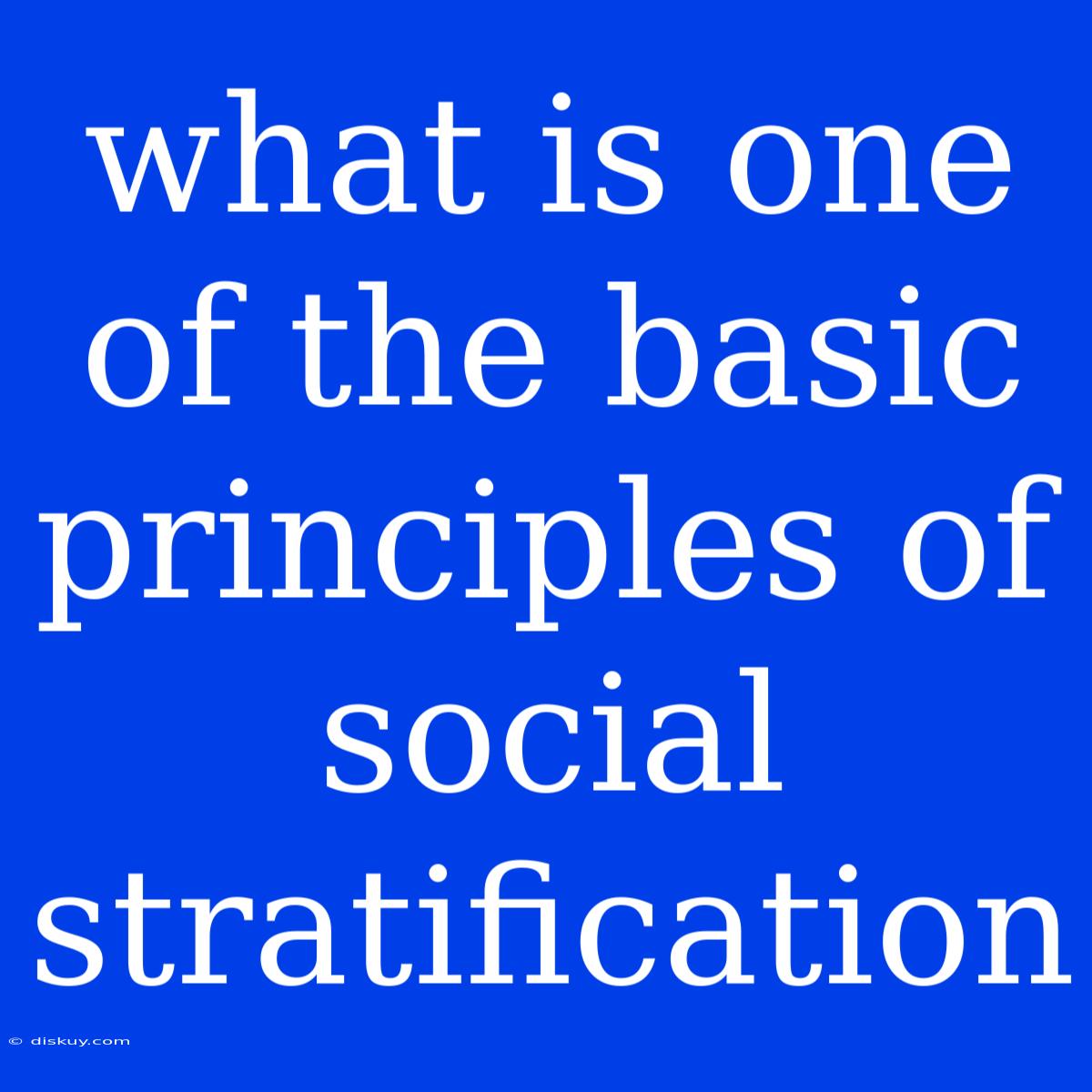What is One of the Basic Principles of Social Stratification?
Is social stratification inevitable, a natural order, or a product of societal structures? One of the fundamental principles of social stratification is the unequal distribution of resources and power within a society. This principle is a core element in understanding how societies are structured and how individuals navigate their place within them.
Editor Note: This article aims to provide insight into the unequal distribution of resources as a fundamental principle of social stratification, helping readers understand its significance and implications.
Why is this important? Understanding this principle is essential for comprehending social dynamics, inequality, and the challenges faced by different social groups. It helps us analyze societal structures and their impact on individual lives, opportunities, and mobility.
Analysis: We delved into various sociological theories and real-world examples to highlight the unequal distribution of resources and power as a key principle of social stratification. This exploration includes examining the role of factors like wealth, income, education, occupation, and social status in shaping social hierarchies.
Key Takeaways
| Aspect | Description |
|---|---|
| Unequal Distribution | Resources like wealth, income, healthcare, and education are unevenly distributed across society. |
| Power Dynamics | Those with greater resources often hold more power and influence, shaping societal rules and institutions. |
| Social Mobility | Limited access to resources and power restricts social mobility, making it harder for individuals to move between social classes. |
Unequal Distribution of Resources
This principle highlights the inherent disparities in access to vital resources across different social groups.
- Wealth and Income: A significant disparity exists in the accumulation and distribution of wealth and income. This creates a clear division between the affluent and those with limited financial means.
- Education and Healthcare: Access to quality education and healthcare services is often linked to socioeconomic status, creating unequal opportunities for individuals to develop their skills and well-being.
- Social Capital: Connections and networks, often referred to as social capital, are unequally distributed. This can affect opportunities for advancement and influence.
Discussion: The unequal distribution of resources has profound implications for social mobility, impacting access to opportunities, shaping life chances, and contributing to the perpetuation of social hierarchies.
Power Dynamics
Those who possess greater control over resources often exert more influence on societal structures and institutions.
- Political Power: Individuals with greater wealth and influence often hold more power in political decision-making, shaping policies that impact resource distribution.
- Economic Power: Corporations and wealthy individuals can exert significant influence on economic policies, impacting labor conditions and resource allocation.
- Social Power: Individuals with higher social status or membership in prestigious groups often enjoy greater influence within specific social spheres.
Discussion: Power dynamics tied to resource allocation contribute to the persistence of social stratification. Those with more power often maintain their advantages, further limiting access for others.
Social Mobility
The ability to move between social classes is crucial for a fair and equitable society. However, the unequal distribution of resources often restricts social mobility.
- Class Barriers: Limited access to quality education, healthcare, and networks can create significant barriers for individuals attempting to move upward in the social hierarchy.
- Intergenerational Mobility: The advantages and disadvantages associated with social class often transfer across generations, perpetuating inequalities.
- Structural Constraints: Societal structures and institutions can reinforce existing inequalities, making it difficult for individuals to overcome systemic barriers.
Discussion: Addressing the unequal distribution of resources is crucial for promoting social mobility, ensuring equitable opportunities, and fostering a more just society.
FAQ
Q: Why is social stratification a natural phenomenon?
A: Social stratification is not inherently natural. While differences in skills, talent, and effort may exist, societal structures and power dynamics create and perpetuate inequalities.
Q: What are the implications of unequal distribution of resources?
**A: **Unequal distribution of resources can lead to social unrest, economic instability, and a lack of social cohesion.
Q: How can social mobility be improved?
A: Promoting equal access to quality education, healthcare, and opportunities can improve social mobility.
Q: Is social stratification always a negative phenomenon?
A: While it can lead to inequality and disadvantage, social stratification can also motivate individuals to strive for success and contribute to society.
Q: What are some examples of social stratification in the real world?
A: Examples include class disparities in access to housing, healthcare, and education; racial and ethnic inequalities in employment and income; and gender gaps in leadership positions and pay.
Tips
- Educate yourself: Learn about social stratification and its implications for different social groups.
- Challenge inequalities: Speak out against unfair practices and policies that perpetuate inequality.
- Support social programs: Advocate for policies that promote equal access to resources and opportunities.
- Promote diversity and inclusion: Create inclusive environments that value the contributions of all individuals.
- Be an active citizen: Participate in civic engagement and advocate for positive change.
Summary
The unequal distribution of resources is a fundamental principle of social stratification. This principle underscores the disparities in access to wealth, income, education, healthcare, and power across different social groups. These disparities often create barriers to social mobility, perpetuating inequality and shaping societal structures.
Closing Message: Understanding this principle is crucial for recognizing the complexities of social structures and advocating for a more equitable and just society. By actively promoting equality and challenging inequalities, we can work towards a world where everyone has access to resources and opportunities.

